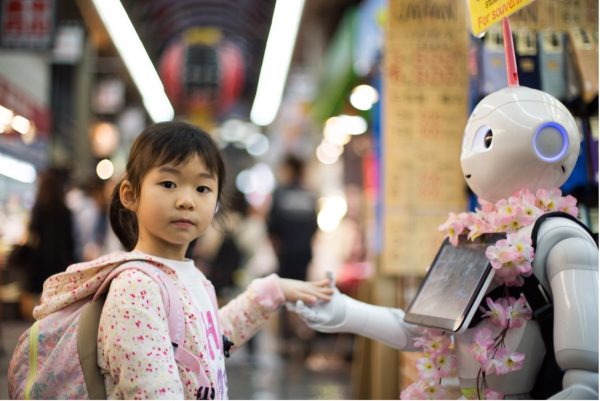Our PR Director, Michelle Smytheman, is passionate about helping emerging professionals in the communications industry and teaches at the University of the Sunshine Coast. As part of an assessment task this year, there have been some excellent blogs written by first-year students about emerging business trends. We are proud to share their work.
By Millie Stocks
Technology. An ever growing, ever evolving concept that we scramble to adapt to every day. One of the latest changes? Robots. Specifically social robots.
 Robots in their most basic form have been around for some time now. But now we are seeing an increase in humanoids – like ElliQ, iPal and Pepper – and animal-like robots – such as aibo and Paro, that provide aided living and the ability to read or react to human expressions. These social robots use artificial intelligence to interact and communicate with humans on an emotional level. So, what is the risk or reward of these robots? Are they as helpful as they seem? Or are there underlying concerns preventing them from being effective and safe?
Robots in their most basic form have been around for some time now. But now we are seeing an increase in humanoids – like ElliQ, iPal and Pepper – and animal-like robots – such as aibo and Paro, that provide aided living and the ability to read or react to human expressions. These social robots use artificial intelligence to interact and communicate with humans on an emotional level. So, what is the risk or reward of these robots? Are they as helpful as they seem? Or are there underlying concerns preventing them from being effective and safe?
Today we look at the top three things you should consider before investing in a social robot, specifically for companionship purposes.
-
Data Storage and Cybersecurity
There are two main types of data storage that a robot might use. Collecting data allows for the creation of comprehensive health records and alerts, which can prove highly beneficial for medical staff and family members, enabling them to provide the most effective assistance. Data sharing with third parties could be used for improving the robot’s performance, conducting marketing activities, or facilitating research. Other data storage includes customisation of the robot, where a robot’s interactions are tailored depending on the needs or wants of the consumer. This can include adapting interactions based on their personality, interests, and emotional states, enhancing the user experience. This helps the robot to offer valuable assistance with daily and repetitive tasks, providing users with practical support in their day-to-day lives.
However, there is a risk associated with the breach of data, which refers to the illegal access of stored data by the company or third parties. This unauthorised access can compromise the privacy and security of user information. In Australia there are multiple policies and legislation in place to help protect consumers from data and privacy related concerns. In Queensland the most prominent are the Privacy Act (1988) and the Consumer Data Right. They aim to protect individual privacy, promote the responsible and transparent handling of confidential information and provide a way for Australians to complain about potential privacy breaches.
-
Surveillance (Audio and Video)
In the context of aged care and assisted living, the robot serves as an alert system for medical issues and assist in everyday physical tasks, enhancing the overall safety and well-being of users. Caregivers also benefit from the robot, which reduces their stress and fatigue, allowing them to provide better care. The robot’s remote connectiveness is a valuable feature that bridges geographical gaps, enabling users to connect with loved ones through video calls and messages, promoting social interaction and emotional well-being.
Concerns arise regarding confidential information when consumers share private details with the robot. Users may wonder if this information can be accessed by unauthorised parties, raising questions about data security and privacy. Recordings of users in bedrooms or private conversations, could be stored on cloud services creating a higher likelihood of hacking. This potential risk can lead to device takeover, where a third party could gain control of the robot, compromising not only the robot itself but also connected systems and potentially exposing confidential information. Ransomware poses a significant threat, as attackers can encrypt the robot’s data or functionality and demand a ransom for its release. This puts user data at risk and underscores the importance of cybersecurity measures.
-
Emotions and Behaviour
A social robot can provide essential services for individuals living alone or requiring extra assistance in their daily lives, therefore addressing the needs of a vulnerable demographic. Research has shown that older adults with dementia and anxiety have benefitted from the companionship, as well as their overall mood, compared to other interventions such as reading. The robot’s emotional support is particularly valuable, especially for the elderly, people with disabilities, or those who are socially isolated. It offers companionship, entertainment, and a sense of connection, addressing emotional well-being. Additionally, the robot can play a role in supporting mental health by offering relaxation techniques, guidance on meditation, mood-boosting activities, and tools to reduce stress and anxiety levels, promoting overall psychological well-being.
However, there is a concern about profiling, as the collection of data on emotions and behaviours can be highly invasive, uncovering sensitive and personal information about individuals without their consent. Invasive profiling raises issues related to psychological privacy, as the analysis of emotions may unveil personal details that individuals wish to keep private, highlighting the importance of respecting emotional boundaries, which a robot cannot differentiate between. Studies show that users often feel uncomfortable when their sensitive information is collected.
It is difficult to predict exactly where this emerging trend of social robots will take us. On one hand, they can be incredibly beneficial in many business and personal settings. On the other, they come with the risk of the unknown and the potential for low privacy. What do you think? Will you be inviting a robot into your home?




